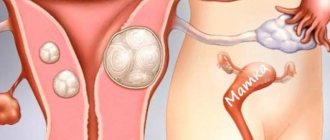Good day!
My name is Khalisat Suleymanova - I am a herbalist. At the age of 28, I cured myself of uterine cancer with herbs (read more about my experience of recovery and why I became a herbalist here: My story). Before being treated using traditional methods described on the Internet, please consult with a specialist and your doctor! This will save your time and money, since the diseases are different, the herbs and treatment methods are different, and there are also concomitant diseases, contraindications, complications, and so on. There is nothing to add yet, but if you need help in selecting herbs and treatment methods, you can find me at my contacts: Khalisat SuleymanovaInstagram page: instagram.com/fitoterapevt1
Telephone: 8
Email: [email protected]
I consult for free.
According to specialist research, it was found that today the most common gynecological pathology is uterine fibroids. Many of them argue that this situation is caused largely due to changes in the environment and lifestyle of the fair sex. From this you can learn more about whether you can do yoga with uterine fibroids, how to perform the exercises and which of them are prohibited.
Causes of the disease
Medical practice shows that the causes of fibroids are not fully understood. Many different factors can affect its appearance. But most practitioners agree that this disease occurs due to hormonal imbalance in the female body.
Treatment of fibroids requires a lot of time and mental energy. It is important to be able to distract yourself from the problem that has arisen and concentrate on achieving your goal, which may be the following: to be cured of an insidious disease.
Very often, a sick woman has a question: is it possible to do yoga if uterine fibroids are diagnosed. The disease itself can occur, accompanied by unpleasant painful sensations in the uterine area, or in their complete absence. If fairly severe pain occurs for no reason, then it indicates a fairly large size of the fibroids.
The growing tumor begins to slowly squeeze nearby organs and interfere with the normal flow of blood through the blood vessels. In this connection, yoga for fibroids must be carried out under the supervision of an experienced instructor, who is important to notify about the presence of this disease.
Medical studies show that the greatest predisposition to the appearance of fibroids is observed in representatives of the fair sex who lead an inactive lifestyle. Blood stagnates in the organs of the female reproductive system, and muscles without daily exercise become weakened and flabby. The muscle tone necessary for health is lost, which contributes to the appearance of fibroids.
Selection of practices
Before practicing yoga, it is necessary to select a practice in accordance with the course of the disease. This is due to the fact that yoga therapy, like other sports, can help increase tumor growth. Growth is achieved due to the flow of blood and oxygen to the tumor.
When choosing the direction of yoga therapy, uterine fibroids are considered from two perspectives:
- progressive neoplasm;
- asymptomatic tumor.
Progressive uterine fibroids are manifested by symptoms expressed to varying degrees:
- bleeding;
- long, heavy menstruation;
- stable growth, which is confirmed by regular ultrasound scans;
- cycle disorders.
In addition, a neoplasm that is characterized by progression may be located on a pedicle. In this clinical situation, yoga should be practiced for therapeutic purposes with many restrictions. It is advisable to exclude from yoga therapy techniques that can provoke further growth of the node, as well as its torsion or necrosis.
From yoga therapy for growing uterine fibroids, it is necessary to exclude so-called abdominal manipulations and techniques that are characterized by an increased impact on this area. Various twisting positions are also undesirable. If you do yoga, there should be no pressure in the abdominal area.
Since most diagnosed fibroids are an incidental finding and are asymptomatic, as is normal, a strict approach to the selection of yoga therapy techniques is not required. Experts say that there is no need to introduce special restrictions and you can gradually perform various elements included in yoga therapy.
Before practicing yoga, you should undergo an examination and consult a doctor. It is advisable that yoga therapy sessions be designed individually in accordance with the clinical picture of the disease and the characteristics of the patient’s medical history. Do not forget about regular gynecological examinations and ultrasound monitoring. If uterine fibroids are diagnosed and yoga therapy is practiced, examination should be carried out every 6 months.
What exercises are recommended for performing?
Simple yoga asanas for diagnosed uterine fibroids are not only indicated for implementation, but are simply necessary to improve a woman’s health. Such exercises help improve the emotional background, and also significantly improve blood supply in the vessels of the female organs, which means that thanks to simple yoga exercises, they are treated.
Practitioners should give their preference to fairly passive tasks; it is not recommended to stay in assumed positions for a long time, and even more so to do something through pain.
Yoga therapy for uterine fibroids promotes:
- relaxing overly tense muscles;
- flexibility in the hip joints;
- elasticity of the muscle corset;
- relieving excessive tension from the sacral region.
It is recommended to start yoga for fibroids with a set of exercises with asanas in a lying position.
As you know, yogic practice implies a mandatory desire to achieve internal harmony. One of the simplest asanas that helps normalize the practitioner’s state of mind is shavasana. Unfortunately, not every woman can easily escape from constantly arising daily problems, especially with a disease such as uterine fibroids. But peace of mind is extremely important for performing shavasana.
This is exactly the relaxing pose, the starting position of which is: lying on your back with your arms extended along your body and your palms facing the ceiling. The practitioner should take a deep breath, then exhale slowly. When performing the asana, the eyes are closed, all muscles are as relaxed as possible. Lie in this position for a quarter of an hour, paying attention to even breathing and mental peace.
What yoga classes should you pay special attention to if you have uterine fibroids:
- Taking a lying position, rhythmically and following a certain sequence, mentally concentrating on the pelvic organs, squeeze and then quite quickly unclench the vaginal muscles for 15 seconds. After this, take a short break. The training can be repeated after some time.
- Squeeze the vaginal muscles tightly and lie in this position for 25 seconds. Rest and repeat the exercise again. When practicing yoga for uterine fibroids daily, it is important to gradually increase the time the muscles are contracted. The maximum you can be in a state of contracted muscles is no more than 2 minutes.
- It is very helpful to perform small pushes, similar to pushing, during the labor process.
- In a lying position, focusing on internal sensations, observing the rhythm, contract the muscles of the female genital organs.
- Forcefully strain the bladder muscles, as if trying to hold back urination. Lie like this for 10 seconds, then relax your muscles. When performing this task, do not rush; it is recommended to perform it slowly, mentally feeling the state of your body.
Regular performance of yoga exercises for uterine fibroids helps improve blood circulation in the uterine cavity and eliminates the occurrence of blood stagnation that is harmful to a woman’s health. In combination with properly selected treatment, a set of exercises affects the improvement of the practitioner’s condition after just a few sessions.
What are Kegel exercises?
The pelvic floor muscles hardly work during normal exercises.
Its development cannot be affected by either playing sports or performing a complex of morning exercises. The condition of the internal muscles is indirectly related to many gynecological diseases: if they are weakened, women develop prolapse of internal organs, urinary incontinence, and phenomena of blood stagnation in the pelvic organs. With uterine fibroids and the sedentary lifestyle associated with it, the internal muscles need constant training. Treatment using Kegel exercises will help strengthen them, relieving the woman of congestion and returning the pelvic organs to their natural position. The exercises are simple and can be done at home, lying on your back.
Initial complex
Exercises done for the first 3 days:
- Squeeze and relax the vaginal muscles, pulling it inward. Perform at a fast pace for 10 seconds. Relax and rest for the next 10 seconds. Repeat the cycle 2 more times.
- Squeeze and relax for 5 seconds. Take a break for 5 seconds. Do it 9 more times.
- Squeeze the vaginal muscles with maximum effort and hold them tense for 30 seconds. Relax for the next 30 seconds. Repeat the exercise 2 more times.
Second set of exercises
After the preparatory stage has been mastered, you can move on to other exercises. They need to be completed within one week:
- While straining your muscles, squeeze your vagina and hold for 5 seconds, relax for 5 seconds and repeat 9 more times.
- Perform 10 squeezing and unclenching movements at a fast pace, rest for 5–10 seconds, and perform 2 more times.
- Squeeze the vaginal muscles and keep them tense for as long as possible (but no more than 2 minutes). Relax for the same amount of time. Repeat 1-2 more times.
Final stage
After doing the exercises for a week, the muscles will not have enough load and you need to perform the third complex:
- At first, perform squeezing and unclenching muscles 30 times, but as the muscles develop, gradually increase the number and bring it to 100 movements. Relax for 30–60 seconds.
- With maximum effort, squeeze the vaginal muscles, fix the tension for 20 seconds. Relax for 30 seconds and perform the exercise 4 more times.
During the day, in any position, you need to additionally squeeze and relax the muscles. This maintenance exercise is done for 2 minutes at least 3 times a day. The movements are invisible to outsiders and can be performed at work, in line, on the subway (sitting or standing).
What yoga exercises are prohibited
If you want to practice yoga with uterine fibroids, it is important to remember that the practitioner should limit herself in performing certain asanas due to existing health problems. Treatment of fibroids is possible only with the proper selection of positions that cannot harm the body.
yoga poses for uterine fibroids
Women who have been diagnosed with uterine fibroids should avoid:
- strong bending of the body in the lumbar area;
- asanas, the execution of which involves twisting the body;
- various external pressures on the abdominal area;
- balancing the body on the hands of a practitioner;
- periodic delays in respiratory rhythms;
- jumping in height and abruptly changing one's position.
In addition, you should not engage in yogic practice if you have the following physical conditions:
- in case of heavy bleeding, any type of training should be immediately excluded;
- when the practitioner is unwell;
- when feeling a strong loss of strength or characteristic depression of morale;
- with discomfort that accompanies the performance of the instructor’s tasks;
- with identified complications of the disease.
Each of the ailments listed above is a signal that yogic practice should be stopped for a while. When the practitioner regains lost strength and morale, she can return to performing asanas.
It is important to remember that some yoga poses that are not indicated for uterine fibroids can not only eliminate the beneficial effects of asanas on the female body, but also worsen the health of the practitioner.
Yoga therapy and exercise
Uterine fibroids do not always require treatment. If an asymptomatic form of the tumor is identified, which is not accompanied by signs of progression, observational tactics can be implemented.
The patient can continue to lead her usual lifestyle, keeping in mind some restrictions. For example, if you have an illness, it is prohibited to sunbathe or perform thermal and vibration procedures on the abdominal area. If you do yoga or other physical activity, you should avoid sudden movements if possible.
It is known that the main method of treating uterine fibroids is surgery. However, if the disease is asymptomatic and there are no malfunctions in the functioning of neighboring organs, conservative therapy is possible, in which yoga is not prohibited.
Yoga is one of the most ancient tactics that helps maintain health and harmony of both body and soul. Yoga therapy is successfully used in the treatment of many diseases, in particular gynecological ones. Thanks to many well-known directions, you can practice yoga for almost any disease.
Many women are interested in whether it is possible to do yoga with uterine fibroids. Yoga for uterine fibroids has the following positive aspects:
- normalizes hormonal levels;
- promotes weight loss;
- lifts your mood and improves your psychological state;
- stabilizes the functioning of the musculoskeletal system, cardiovascular and respiratory systems.
Basics of Iyengar yoga for uterine fibroids
Experts who have been studying this ancient practice for decades advise women with uterine fibroids to pay attention to the teachings of Iyengar yoga.
Distinctive features of this practice and why it is beneficial specifically for the female body:
- The main feature that is characteristic of this teaching is the performance of asanas in a static position of the practitioner’s body. This feature is one of the main requirements for practicing yoga for uterine fibroids. The person takes the pose indicated by the instructor and maintains it for a certain time, as if frozen in place. Iyengar yoga asanas for uterine fibroids, performed in a static position, have a powerful therapeutic effect on the condition of internal organs and muscles.
- The female body is unique and unusual. Iyengar yoga was created specifically for him. With the help of asanas performed in this technique, the practitioner learns to feel her sensations and follow the true desires of her body.
With regular practice, the practitioner will not only improve her health, but will also perk up and gain inner harmony, which is necessary to cure the body of illness. Treatment of fibroids with yoga is possible only with an integrated approach. In addition to performing yogic asanas, a woman must follow all the instructions of the attending physician.
If you find an error, please select a piece of text and press Ctrl+Enter.
Properly selected physical exercises for uterine fibroids can become part of the overall treatment process. A dosed load on the muscles of the pelvic area eliminates blood stagnation in the vessels, strengthens the muscle corset, and makes the ligaments elastic. All together, this helps eliminate some of the painful symptoms and significantly improves the woman’s quality of life.
How physical activity affects the growth of myomatous node
Myoma is understood as a benign, dense neoplasm formed due to the proliferation of myometrial cells - the muscular layer of the uterus. Properly selected yoga asanas and physical exercises for the treatment of uterine fibroids give a positive effect in the presence of small nodes - not exceeding 2.5 cm in diameter. They may decrease in size to clinically insignificant parameters. In this case, the patient will no longer be bothered by the symptoms of the disease. What is the effect of yoga and exercises for uterine fibroids:
- A woman’s weight decreases, and adipose tissue contains a natural depot of female sex hormones - estrogens, which provoke the growth of tumors.
- The muscles of the perineum and abdomen are strengthened, which helps maintain the uterus and other pelvic organs in their places, and also prevents them from moving under the pressure of increasing nodes.
- The woman’s immunity is strengthened and, as a result, the risk of developing inflammatory processes in the organs of the reproductive system is reduced, which will adversely affect the development of the tumor.
What exercises can you do with fibroids?
Only a specialist can choose the right exercise therapy complex for patients diagnosed with uterine fibroids. But besides special therapeutic measures, there are many ways to normalize your physical activity.
Among the sports activities that are allowed to patients with fibroids are swimming, walking and Nordic walking, breathing exercises, etc.
The most useful and accessible exercises for women suffering from fibroids are exercises that can be done independently. These include:
- Kegel exercises to strengthen the pelvic floor muscles;
- some yoga asanas;
- a set of exercises by Dr. Bubnovsky.
Before starting exercise, a woman should consult with her doctor to be sure that the chosen physical exercises will not cause harm specifically for this particular form and stage of fibroid development.
Exercises for patients with fibroids also have their own contraindications. If bleeding and pain appear during exercise or some time after it, or your health becomes worse, then the exercises should be stopped. The woman should see a doctor and let him know why her condition has worsened.
You cannot start gymnastics classes if:
- tumor growth is activated (the doctor can inform you about this);
- there is uterine bleeding;
- there are complications of fibroids or concomitant diseases;
- discomfort or pain is felt during the exercise;
- for unknown reasons, dizziness, loss of strength, and general malaise occur.
Performing any physical exercise in the presence of these conditions can cause harm to a woman’s body and complicate the course of the disease.
The benefits of training
Regular yoga and other physical activities improve the condition of women diagnosed with small uterine fibroids - up to 2.5 cm in diameter. But in the presence of benign tumors, not all exercises can be performed. If you ignore the prohibitions, you can provoke the growth of a node. Exercises using the Bubnovsky method allow you to reduce the size of the tumor to clinically insignificant parameters. Some exercises from the Kegel complex, yoga and exercise therapy help to reduce knots. Regular water aerobics classes and morning exercises will give good results, but with restrictions on exercises. It is useful for ladies to swim, exercise on an exercise bike and run at a slow pace.
Yoga asanas for uterine fibroids
It is better to perform these exercises with an instructor and only after consulting with your doctor about whether it is possible to practice yoga in an individual case of illness. Once the recommended asanas are mastered in classes with a trainer, they can be done at home.
Precautionary measures
You cannot do exercises related to the following movements:
- with deep bends back;
- with twisting of the body;
- with pressure on the abdominal area;
- with breath holdings;
- with any sudden movements or jumps.
Yoga for uterine fibroids includes performing relaxing asanas: shavasana, uddiyana and similar poses. When performing shavasana (lying on your back, with your hands facing the ceiling), you can make movements similar to the Kegel exercises described above. In yogic practice, muscle tension and relaxation occurs more smoothly. In this case, muscle tension should increase gradually to a maximum, and then they relax just as slowly. 1 cycle of tension-relaxation takes approximately 1 minute. You can perform 3-5 such cycles.
Warm-up
To perform the Uterine Breathing exercise, you will need to warm up:
- The woman stands in the basic stance (arms down, feet at a distance of 10 cm from each other, head straight, without tension). From this and. p. you need to perform 3-5 smooth movements with your hands up and down with full amplitude (similar to flapping wings).
- Then place your feet shoulder-width apart and perform shallow squats (bend your knees slightly), tilting your body forward. Repeat 3-5 times.
- Roll from toes to heels slowly for 30 seconds.
Basic asanas
After warming up, perform several asanas that transform into one another and are performed in a continuous, single, smooth movement:
- Standing in the main stance, bend your legs into a half-squat and bend down, touching the floor. Try to straighten your legs without taking your hands off the floor and raising your head.
- Bend your legs, resting on your palms and push your legs as far back as possible (left, right), taking a stance as for push-ups. Head lowered, looking at the floor.
- Bend your knees, lower your buttocks onto your heels, without lifting your hands from the floor. Raise your head, looking ahead.
- Lowering your head, slide your entire body forward above the floor, straightening your knees. At the end of the movement, the head and chest move upward.
- Lowering your head, bend your knees, take a stance on all fours and round your back.
- Lower your head all the way to the floor. Leaning on your hands, smoothly straighten your legs. Keep your back straight, with your buttocks at the “vertex of the triangle.” Hold this pose for 20 seconds, inhaling and exhaling freely, trying to stretch your buttocks towards the ceiling.
- Raise your right leg up so that it continues the line of your back, and then move it forward, bending at the knee. Straightening your leg, straighten your back and take a vertical position. At the same time, the legs are in a wide step (the right one is in front). Raise your arms above your head, joining your palms, your eyes following them.
- Bend your right knee slightly and lower your joined hands in front of your face (as in namaste). Straighten your knee and raise your arms up again, lower your palms to the floor in a large circle, smoothly bending down and bending your right knee.
- Lean on your hands and put your right leg back, again taking a push-up stance.











